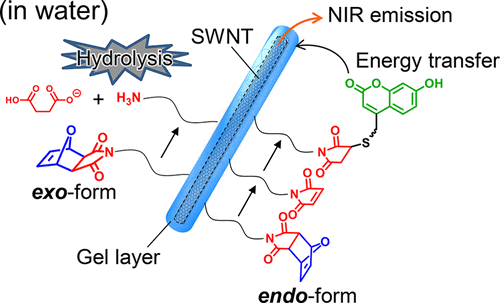当前位置:
X-MOL 学术
›
J. Am. Chem. Soc.
›
论文详情
Our official English website, www.x-mol.net, welcomes your
feedback! (Note: you will need to create a separate account there.)
Synthesis of Single-walled Carbon Nanotubes Coated with Thiol-reactive Gel via Emulsion Polymerization
Journal of the American Chemical Society ( IF 14.4 ) Pub Date : 2018-06-15 , DOI: 10.1021/jacs.8b03873 Yukiko Nagai 1 , Yusuke Tsutsumi 1 , Naotoshi Nakashima 2 , Tsuyohiko Fujigaya 1, 2, 3, 4
Journal of the American Chemical Society ( IF 14.4 ) Pub Date : 2018-06-15 , DOI: 10.1021/jacs.8b03873 Yukiko Nagai 1 , Yusuke Tsutsumi 1 , Naotoshi Nakashima 2 , Tsuyohiko Fujigaya 1, 2, 3, 4
Affiliation

|
Single-walled carbon nanotubes (SWNTs) have unique near-infrared absorption and photoemission properties that are attractive for in vivo biological applications such as photothermal cancer treatment and bioimaging. Therefore, a smart functionalization strategy for SWNTs to create biocompatible surfaces and introduce various ligands to target active cancer cells without losing the unique optical properties of the SWNTs is strongly desired. This paper reports the design and synthesis of a SWNT/gel hybrid containing maleimide groups, which react with various thiol compounds through Michael addition reactions. In this hybrid, the method called carbon nanotube micelle polymerization was used to noncovalently modify the surface of SWNTs with a cross-linked polymer gel layer. This method can form an extremely stable gel layer on SWNTs; such stability is essential for in vivo biological applications. The monomer used to form the gel layer contained a maleimide group, which was protected with furan in endo-form. The resulting hybrid was treated in water to induce deprotection via a retro-Diels-Alder reaction and then functionalized with thiol compounds through Michael addition. The functionalization of the hybrid was explored using a thiol-containing fluorescent dye as a model thiol, and the formation of the SWNT-dye conjugate was confirmed by energy transfer from the dye to SWNTs. Our strategy offers a promising SWNT-based platform for biological functionalization for cancer targeting, imaging, and treatment.
中文翻译:

乳液聚合法合成硫醇反应凝胶包覆的单壁碳纳米管
单壁碳纳米管 (SWNT) 具有独特的近红外吸收和光发射特性,对体内生物应用(如光热癌症治疗和生物成像)具有吸引力。因此,强烈需要一种用于 SWNT 的智能功能化策略,以创建生物相容性表面并引入各种配体以靶向活性癌细胞而不会失去 SWNT 的独特光学特性。本文报道了含有马来酰亚胺基团的 SWNT/凝胶杂化物的设计和合成,该基团通过迈克尔加成反应与各种硫醇化合物反应。在这种混合体中,使用称为碳纳米管胶束聚合的方法通过交联聚合物凝胶层对 SWNT 的表面进行非共价改性。这种方法可以在单壁碳纳米管上形成极其稳定的凝胶层;这种稳定性对于体内生物学应用至关重要。用于形成凝胶层的单体含有马来酰亚胺基团,该基团被内型呋喃保护。将所得杂化物在水中处理以通过逆狄尔斯-阿尔德反应诱导脱保护,然后通过迈克尔加成用硫醇化合物官能化。使用含硫醇的荧光染料作为模型硫醇探索了杂化物的功能化,并且通过从染料到 SWNT 的能量转移证实了 SWNT 染料共轭物的形成。我们的策略为癌症靶向、成像和治疗的生物功能化提供了一个有前景的基于 SWNT 的平台。将所得杂化物在水中处理以通过逆狄尔斯-阿尔德反应诱导脱保护,然后通过迈克尔加成用硫醇化合物官能化。使用含硫醇的荧光染料作为模型硫醇探索了杂化物的功能化,并且通过从染料到 SWNT 的能量转移证实了 SWNT 染料共轭物的形成。我们的策略为癌症靶向、成像和治疗的生物功能化提供了一个有前景的基于 SWNT 的平台。将所得杂化物在水中处理以通过逆狄尔斯-阿尔德反应诱导脱保护,然后通过迈克尔加成用硫醇化合物官能化。使用含硫醇的荧光染料作为模型硫醇探索了杂化物的功能化,并且通过从染料到 SWNT 的能量转移证实了 SWNT 染料共轭物的形成。我们的策略为癌症靶向、成像和治疗的生物功能化提供了一个有前景的基于 SWNT 的平台。并且通过从染料到 SWNT 的能量转移证实了 SWNT-染料共轭物的形成。我们的策略为癌症靶向、成像和治疗的生物功能化提供了一个有前景的基于 SWNT 的平台。并且通过从染料到 SWNT 的能量转移证实了 SWNT-染料共轭物的形成。我们的策略为癌症靶向、成像和治疗的生物功能化提供了一个有前景的基于 SWNT 的平台。
更新日期:2018-06-15
中文翻译:

乳液聚合法合成硫醇反应凝胶包覆的单壁碳纳米管
单壁碳纳米管 (SWNT) 具有独特的近红外吸收和光发射特性,对体内生物应用(如光热癌症治疗和生物成像)具有吸引力。因此,强烈需要一种用于 SWNT 的智能功能化策略,以创建生物相容性表面并引入各种配体以靶向活性癌细胞而不会失去 SWNT 的独特光学特性。本文报道了含有马来酰亚胺基团的 SWNT/凝胶杂化物的设计和合成,该基团通过迈克尔加成反应与各种硫醇化合物反应。在这种混合体中,使用称为碳纳米管胶束聚合的方法通过交联聚合物凝胶层对 SWNT 的表面进行非共价改性。这种方法可以在单壁碳纳米管上形成极其稳定的凝胶层;这种稳定性对于体内生物学应用至关重要。用于形成凝胶层的单体含有马来酰亚胺基团,该基团被内型呋喃保护。将所得杂化物在水中处理以通过逆狄尔斯-阿尔德反应诱导脱保护,然后通过迈克尔加成用硫醇化合物官能化。使用含硫醇的荧光染料作为模型硫醇探索了杂化物的功能化,并且通过从染料到 SWNT 的能量转移证实了 SWNT 染料共轭物的形成。我们的策略为癌症靶向、成像和治疗的生物功能化提供了一个有前景的基于 SWNT 的平台。将所得杂化物在水中处理以通过逆狄尔斯-阿尔德反应诱导脱保护,然后通过迈克尔加成用硫醇化合物官能化。使用含硫醇的荧光染料作为模型硫醇探索了杂化物的功能化,并且通过从染料到 SWNT 的能量转移证实了 SWNT 染料共轭物的形成。我们的策略为癌症靶向、成像和治疗的生物功能化提供了一个有前景的基于 SWNT 的平台。将所得杂化物在水中处理以通过逆狄尔斯-阿尔德反应诱导脱保护,然后通过迈克尔加成用硫醇化合物官能化。使用含硫醇的荧光染料作为模型硫醇探索了杂化物的功能化,并且通过从染料到 SWNT 的能量转移证实了 SWNT 染料共轭物的形成。我们的策略为癌症靶向、成像和治疗的生物功能化提供了一个有前景的基于 SWNT 的平台。并且通过从染料到 SWNT 的能量转移证实了 SWNT-染料共轭物的形成。我们的策略为癌症靶向、成像和治疗的生物功能化提供了一个有前景的基于 SWNT 的平台。并且通过从染料到 SWNT 的能量转移证实了 SWNT-染料共轭物的形成。我们的策略为癌症靶向、成像和治疗的生物功能化提供了一个有前景的基于 SWNT 的平台。











































 京公网安备 11010802027423号
京公网安备 11010802027423号